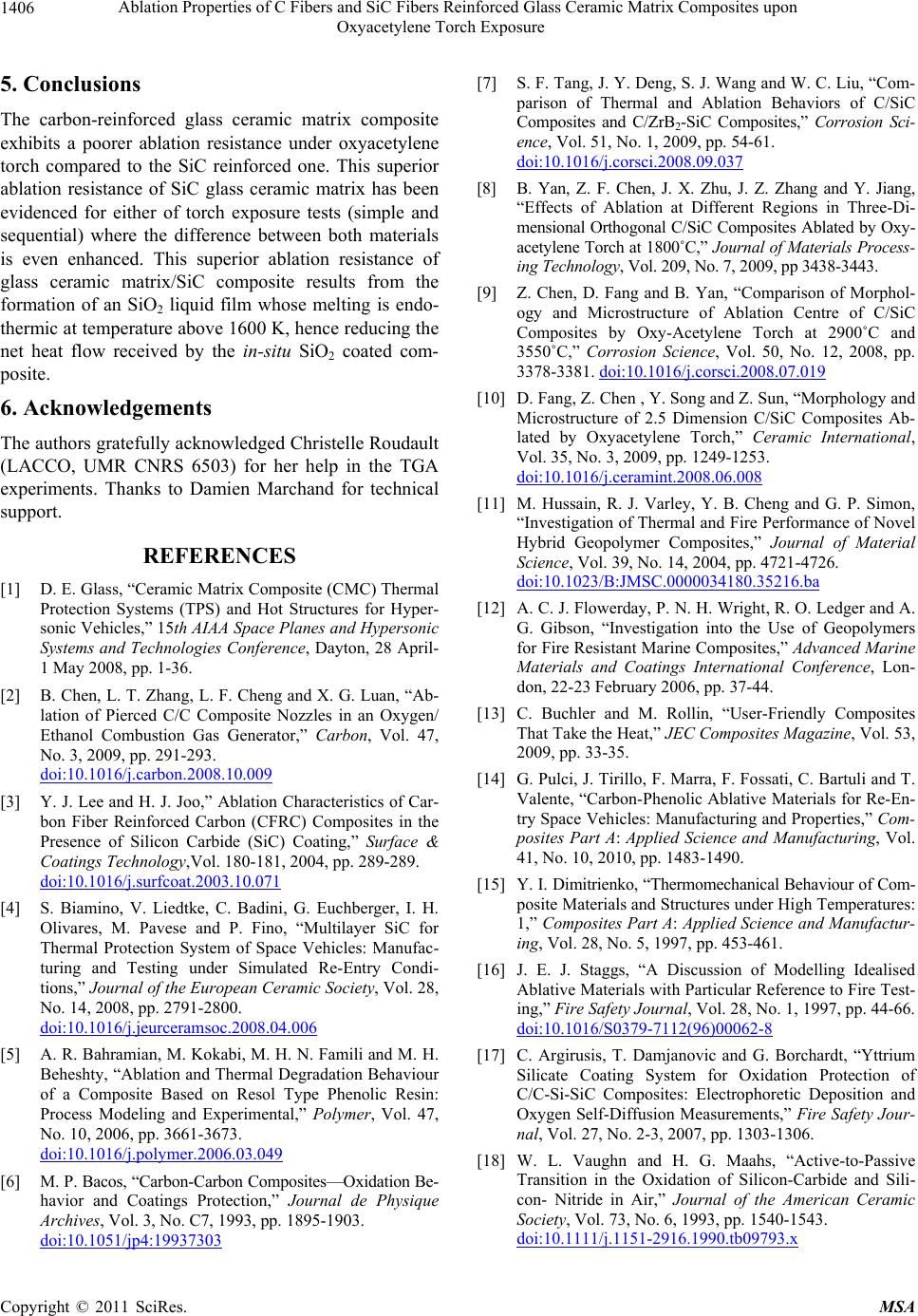
Ablation Properties of C Fibers and SiC Fibers Reinforced Glass Ceramic Matrix Composites upon
1406
Oxyacetylene Torch Exposure
5. Conclusions
The carbon-reinforced glass ceramic matrix composite
exhibits a poorer ablation resistance under oxyacetylene
torch compared to the SiC reinforced one. This superior
ablation resistance of SiC glass ceramic matrix has been
evidenced for either of torch exposure tests (simple and
sequential) where the difference between both materials
is even enhanced. This superior ablation resistance of
glass ceramic matrix/SiC composite results from the
formation of an SiO2 liquid film whose melting is endo-
thermic at temperature above 1600 K, hence reducing the
net heat flow received by the in-situ SiO2 coated com-
posite.
6. Acknowledgements
The authors gratefully acknowledged Christelle Roudault
(LACCO, UMR CNRS 6503) for her help in the TGA
experiments. Thanks to Damien Marchand for technical
support.
REFERENCES
[1] D. E. Glass, “Ceramic Matrix Composite (CMC) Thermal
Protection Systems (TPS) and Hot Structures for Hyper-
sonic Vehicles,” 15th AIAA Space Planes and Hypersonic
Systems and Technologies Conference, Dayton, 28 April-
1 May 2008, pp. 1-36.
[2] B. Chen, L. T. Zhang, L. F. Cheng and X. G. Luan, “Ab-
lation of Pierced C/C Composite Nozzles in an Oxygen/
Ethanol Combustion Gas Generator,” Carbon, Vol. 47,
No. 3, 2009, pp. 291-293.
doi:10.1016/j.carbon.2008.10.009
[3] Y. J. Lee and H. J. Joo,” Ablation Characteristics of Car-
bon Fiber Reinforced Carbon (CFRC) Composites in the
Presence of Silicon Carbide (SiC) Coating,” Surface &
Coatings Technology,Vol. 180-181, 2004, pp. 289-289.
doi:10.1016/j.surfcoat.2003.10.071
[4] S. Biamino, V. Liedtke, C. Badini, G. Euchberger, I. H.
Olivares, M. Pavese and P. Fino, “Multilayer SiC for
Thermal Protection System of Space Vehicles: Manufac-
turing and Testing under Simulated Re-Entry Condi-
tions,” Journal of the European Ceramic Society, Vol. 28,
No. 14, 2008, pp. 2791-2800.
doi:10.1016/j.jeurceramsoc.2008.04.006
[5] A. R. Bahramian, M. Kokabi, M. H. N. Famili and M. H.
Beheshty, “Ablation and Thermal Degradation Behaviour
of a Composite Based on Resol Type Phenolic Resin:
Process Modeling and Experimental,” Polymer, Vol. 47,
No. 10, 2006, pp. 3661-3673.
doi:10.1016/j.polymer.2006.03.049
[6] M. P. Bacos, “Carbon-Carbon Composites—Oxidation Be-
havior and Coatings Protection,” Journal de Physique
Archives, Vol. 3, No. C7, 1993, pp. 1895-1903.
doi:10.1051/jp4:19937303
[7] S. F. Tang, J. Y. Deng, S. J. Wang and W. C. Liu, “Com-
parison of Thermal and Ablation Behaviors of C/SiC
Composites and C/ZrB2-SiC Composites,” Corrosion Sci-
ence, Vol. 51, No. 1, 2009, pp. 54-61.
doi:10.1016/j.corsci.2008.09.037
[8] B. Yan, Z. F. Chen, J. X. Zhu, J. Z. Zhang and Y. Jiang,
“Effects of Ablation at Different Regions in Three-Di-
mensional Orthogonal C/SiC Composites Ablated by Oxy-
acetylene Torch at 1800˚C,” Journal of Materials Process-
ing Technology, Vol. 209, No. 7, 2009, pp 3438-3443.
[9] Z. Chen, D. Fang and B. Yan, “Comparison of Morphol-
ogy and Microstructure of Ablation Centre of C/SiC
Composites by Oxy-Acetylene Torch at 2900˚C and
3550˚C,” Corrosion Science, Vol. 50, No. 12, 2008, pp.
3378-3381. doi:10.1016/j.corsci.2008.07.019
[10] D. Fang, Z. Chen , Y. Song and Z. Sun, “Morphology and
Microstructure of 2.5 Dimension C/SiC Composites Ab-
lated by Oxyacetylene Torch,” Ceramic International,
Vol. 35, No. 3, 2009, pp. 1249-1253.
doi:10.1016/j.ceramint.2008.06.008
[11] M. Hussain, R. J. Varley, Y. B. Cheng and G. P. Simon,
“Investigation of Thermal and Fire Performance of Novel
Hybrid Geopolymer Composites,” Journal of Material
Science, Vol. 39, No. 14, 2004, pp. 4721-4726.
doi:10.1023/B:JMSC.0000034180.35216.ba
[12] A. C. J. Flowerday, P. N. H. Wright, R. O. Ledger and A.
G. Gibson, “Investigation into the Use of Geopolymers
for Fire Resistant Marine Composites,” Advanced Marine
Materials and Coatings International Conference, Lon-
don, 22-23 February 2006, pp. 37-44.
[13] C. Buchler and M. Rollin, “User-Friendly Composites
That Take the Heat,” JEC Composites Magazine, Vol. 53,
2009, pp. 33-35.
[14] G. Pulci, J. Tirillo, F. Marra, F. Fossati, C. Bartuli and T.
Valente, “Carbon-Phenolic Ablative Materials for Re-En-
try Space Vehicles: Manufacturing and Properties,” Com-
posites Part A: Applied Science and Manufacturing, Vol.
41, No. 10, 2010, pp. 1483-1490.
[15] Y. I. Dimitrienko, “Thermomechanical Behaviour of Com-
posite Materials and Structures under High Temperatures:
1,” Composites Part A: Applied Science and Manufactur-
ing, Vol. 28, No. 5, 1997, pp. 453-461.
[16] J. E. J. Staggs, “A Discussion of Modelling Idealised
Ablative Materials with Particular Reference to Fire Test-
ing,” Fire Safety Journal, Vol. 28, No. 1, 1997, pp. 44-66.
doi:10.1016/S0379-7112(96)00062-8
[17] C. Argirusis, T. Damjanovic and G. Borchardt, “Yttrium
Silicate Coating System for Oxidation Protection of
C/C-Si-SiC Composites: Electrophoretic Deposition and
Oxygen Self-Diffusion Measurements,” Fire Safety Jour-
nal, Vol. 27, No. 2-3, 2007, pp. 1303-1306.
[18] W. L. Vaughn and H. G. Maahs, “Active-to-Passive
Transition in the Oxidation of Silicon-Carbide and Sili-
con- Nitride in Air,” Journal of the American Ceramic
Society, Vol. 73, No. 6, 1993, pp. 1540-1543.
doi:10.1111/j.1151-2916.1990.tb09793.x
Copyright © 2011 SciRes. MSA